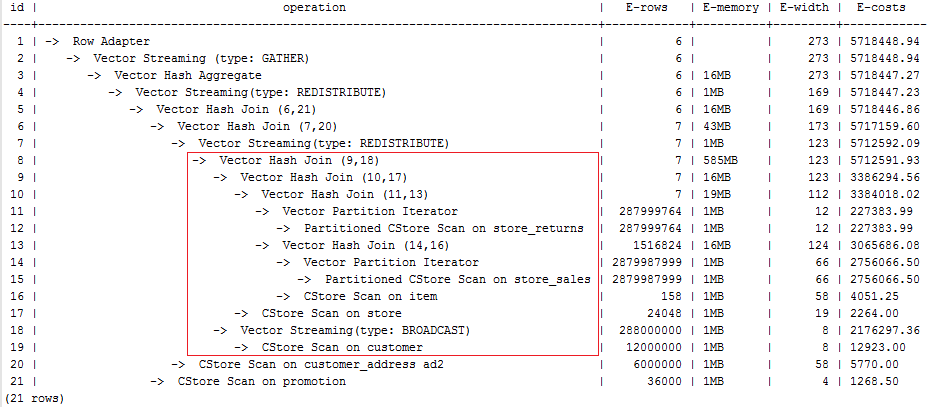Stream方式的Hint
功能描述
指明stream使用的方法,可以为broadcast和redistribute,或者直接指定生成gather计划。
语法格式
1 2 |
[no] broadcast|redistribute(table_list) gather(REL|JOIN|ALL) |
参数说明
- broadcast和redistribute
- no表示hint的stream方式不使用。
- table_list为进行stream操作的单表或多表join结果集,见参数说明。
- gather
gather hint可以指定三种计划生成方式:
- REL:只生成基于基表的gather路径,然后再在CN上执行剩余计划。
- JOIN:尽可能生成基于join的gather路径,在能下推的join子计划上面(join下面不包含重分布节点)添加gather路径,剩余计划在CN上执行。对于需要重分布节点的join计划则生成不出这种基于join的gather路径,会回退生成基于基表的gather路径。

在指定Hint(JOIN)后,对于分布表和复制表做连接的情况会导致生成不出来Hint(JOIN)期望的计划,因为优化器已经寻找更优的计划进行替代。
- ALL:基于最优方式选择Gather Rel或Gather Join路径。
示例
对示例中原语句使用如下hint:
1 2 |
explain select /*+ no redistribute(store_sales store_returns item store) leading(((store_sales store_returns item store) customer)) */ i_product_name product_name ... |
原计划中,(store_sales store_returns item store)和customer做join时,前者做了重分布,此hint表示禁止前者混合表做重分布,但仍然保持join顺序,则生成计划如下所示:

对语句进行Gather Hint指定:
- 生成基表Gather计划 /* +GATHER(REL)*/。
openGauss=# explain select /*+ GATHER(REL)*/* from t1, t2, t3 where t1.c2 = t2.c2 and t2.c2 = t3.c2; QUERY PLAN ------------------------------------------------------------------------------- Hash Join (cost=3.29..5.08 rows=10 width=24) Hash Cond: (t1.c2 = t3.c2) -> Hash Join (cost=1.64..3.30 rows=10 width=16) Hash Cond: (t1.c2 = t2.c2) -> Streaming (type: GATHER) (cost=0.31..1.52 rows=10 width=8) Node/s: All datanodes -> Seq Scan on t1 (cost=0.00..1.05 rows=10 width=8) -> Hash (cost=1.52..1.52 rows=10 width=8) -> Streaming (type: GATHER) (cost=0.31..1.52 rows=10 width=8) Node/s: All datanodes -> Seq Scan on t2 (cost=0.00..1.05 rows=10 width=8) -> Hash (cost=1.52..1.52 rows=10 width=8) -> Streaming (type: GATHER) (cost=0.31..1.52 rows=10 width=8) Node/s: All datanodes -> Seq Scan on t3 (cost=0.00..1.05 rows=10 width=8) (15 rows)
- 生成可下推计划的Join Gather计划 /*+ GATHER(REL)*/。
openGauss=# explain select /*+ GATHER(JOIN)*/* from t1, t2, t3 where t1.c1 = t2.c1 and t2.c2 = t3.c2; QUERY PLAN --------------------------------------------------------------------------- Hash Join (cost=2.76..4.48 rows=10 width=24) Hash Cond: (t2.c2 = t3.c2) -> Streaming (type: GATHER) (cost=1.43..2.70 rows=10 width=16) Node/s: All datanodes -> Hash Join (cost=1.11..2.23 rows=10 width=16) Hash Cond: (t1.c1 = t2.c1) -> Seq Scan on t1 (cost=0.00..1.05 rows=10 width=8) -> Hash (cost=1.05..1.05 rows=10 width=8) -> Seq Scan on t2 (cost=0.00..1.05 rows=10 width=8) -> Hash (cost=1.52..1.52 rows=10 width=8) -> Streaming (type: GATHER) (cost=0.31..1.52 rows=10 width=8) Node/s: All datanodes -> Seq Scan on t3 (cost=0.00..1.05 rows=10 width=8) (13 rows)
- 生成最优方式的Gather计划 /*+ GATHER(ALL)*/。
会基于最优方式及规则选择GATHER(REL)或者GATHER(JOIN)路径。
openGauss=# explain select /*+ GATHER(ALL)*/* from t1, t2, t3 where t1.c1 = t2.c1 and t2.c2 = t3.c2; QUERY PLAN --------------------------------------------------------------------------- Hash Join (cost=2.76..4.48 rows=10 width=24) Hash Cond: (t2.c2 = t3.c2) -> Streaming (type: GATHER) (cost=1.43..2.70 rows=10 width=16) Node/s: All datanodes -> Hash Join (cost=1.11..2.23 rows=10 width=16) Hash Cond: (t1.c1 = t2.c1) -> Seq Scan on t1 (cost=0.00..1.05 rows=10 width=8) -> Hash (cost=1.05..1.05 rows=10 width=8) -> Seq Scan on t2 (cost=0.00..1.05 rows=10 width=8) -> Hash (cost=1.52..1.52 rows=10 width=8) -> Streaming (type: GATHER) (cost=0.31..1.52 rows=10 width=8) Node/s: All datanodes -> Seq Scan on t3 (cost=0.00..1.05 rows=10 width=8) (13 rows)







